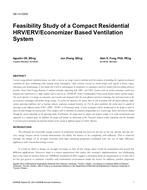Description
Current energy-efficient residential houses use either a heat or an energy recovery ventilator with the purpose of providing the required mechanical ventilation for space conditioning while reducing energy consumption. After extensive research on current designs with regards to theory, usages, advantages and disadvantages, it was found that it will be advantageous to incorporate an economizer control to benefit from free-cooling whenever possible. Anew Total Energy Recovery Ventilator prototype integrating both HRV and ERV features with an airside economizer control was designed and constructed as a single compact unit as part of an ASHRAE Senior Undergraduate Project grant funded student capstone project. The main objective is to design an innovative and versatile unit integrated with the most efficient and latest technology that will lead society to the use of greener technologies and further energy savings. To achieve the objectives, the system must be able to perform with the highest efficiency under various operating conditions such as location, climate, occupancy, occupant behavior, etc. For the given conditions, the system must be capable of operating in four different modes; ERV, HRV, TERV or Economizer mode. A series of dampers will be incorporated in the design in order to direct the flow through the desired path. These dampers will be controlled by actuators, programmed by a control logic, which will lead the airflow through the system depending on the operating mode. Furthermore, the design must be simple and compact enough to be easily maintainable and adaptable to a confined space. In addition, the design will include an illustration of the Transient software model simulation and the developed Excel tool used to determine the potential benefits of the system in different regions of North America.
Citation: ASHRAE Papers CD: 2014 ASHRAE Annual Conference, Seattle, WA
Product Details
- Published:
- 2014
- Number of Pages:
- 8
- File Size:
- 1 file , 2.3 MB
- Product Code(s):
- D-SE-14-C009




